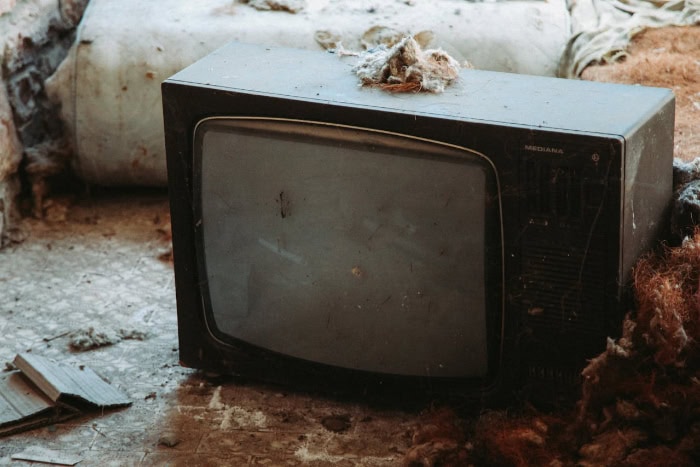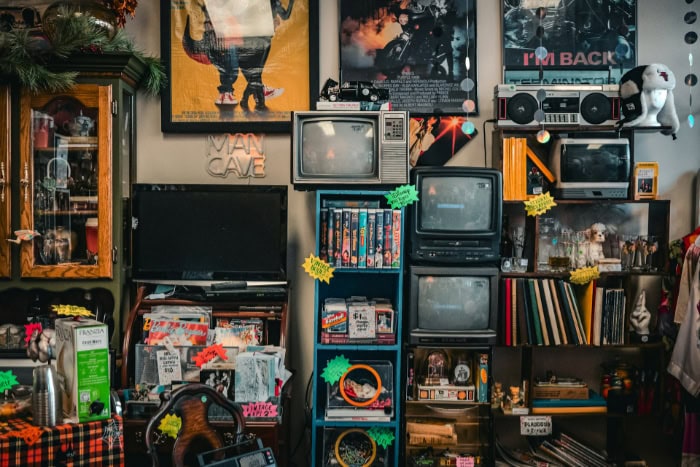What to Do With a Broken TV: Fix, Recycle, or Transform

Your TV screen goes dark unexpectedly. The sound cuts out. Perhaps there's a worrying crack across the display. These moments of technological failure can leave you frustrated and unsure of what to do next.
A broken TV doesn't have to mean an automatic trip to the electronics store for a replacement. There are several options to consider, from repair and recycling to creative repurposing.
Making an informed decision about your malfunctioning television not only saves money but can also benefit the environment.
Assess the Damage
Before deciding what to do with your broken TV, it's crucial to assess the extent of the damage. By identifying the specific issue, you can determine whether repair is feasible or if replacement is necessary.
Identifying Common TV Problems
Several issues can cause a TV to malfunction. Some of the most common problems include:
- No power: The TV won't turn on, indicating a potential issue with the power supply or internal components.
- Display issues: Cracked screens, color distortion, or dead pixels can signify damage to the display panel or underlying hardware.
- Sound problems: Absence of sound or distorted audio may point to issues with the speakers, audio processing unit, or connections.
- Connectivity troubles: Difficulty connecting to external devices or accessing smart TV features can suggest problems with ports, software, or network components.
Basic Troubleshooting Steps
Before seeking professional help, try these basic troubleshooting steps:
- Check power connections: Ensure the TV is properly plugged in and the outlet is functioning.
- Inspect cables: Look for damaged or loose cables connecting your TV to external devices.
- Soft reset: Unplug the TV, wait 30 seconds, and plug it back in to see if the issue resolves.
- Review settings: Check if the problem persists across different inputs or if adjusting settings, such as picture mode or sound settings, helps.
If these steps don't resolve the issue, it's time to consider professional assistance.
Professional Diagnosis Options
When basic troubleshooting fails, consult with a professional technician. Options include:
- Manufacturer support: Contact your TV's manufacturer for guidance or to schedule a repair.
- Local repair shops: Take your TV to a reputable electronics repair shop for a diagnosis and repair estimate.
- In-home services: Some companies offer in-home diagnostic and repair services for added convenience.
Be sure to choose a service provider with experience in your TV's brand and model.
Cost Estimation Guidelines
The cost of repairing a broken TV varies depending on factors such as the specific issue, TV size, brand, and age. As a general guideline:
- Minor repairs: Issues like loose connections or software glitches may cost between $50 to $200 to fix.
- Moderate repairs: Problems with individual components, such as power boards or backlights, can range from $200 to $500.
- Major repairs: Severe damage to the display panel or extensive component failure may cost $500 or more to repair.
In some cases, the repair cost may approach or exceed the price of a new TV. Consider the age and value of your current TV when deciding whether to repair or replace it.
Repair Considerations

Once you've assessed the damage to your TV, the next step is to determine whether repairing it is a viable option. Several factors come into play when making this decision, including the cost of repairs, the age and value of your TV, and your comfort level with attempting a fix yourself.
When Repair Makes Financial Sense
Repairing your TV can be a cost-effective solution in certain situations. If the problem is small, such as a loose connection or a software glitch, repair costs may be minimal compared to buying a new TV.
Similarly, if your TV is relatively new or a premium model, repairing it may be more economical than replacing it entirely. In some cases, if the TV holds emotional significance or is part of a custom setup, repair may be preferable to replacement.
However, if the repair cost approaches or exceeds the price of a comparable new TV, replacement may be the better choice.
Common Repair Costs by Issue Type
The cost of repairing a TV varies depending on the specific problem. Fixing power-related issues typically ranges from $100 to $300, while repairing or replacing a damaged screen can cost anywhere from $200 to $1,000 or more, depending on the TV size and technology.
Replacing faulty LED backlights usually falls between $100 and $500, and resolving sound issues, such as replacing speakers, can cost $100 to $300.
Keep in mind that these are general estimates, and actual costs may vary based on factors like brand, model, and technician rates.
DIY Repair Possibilities
In some cases, you may be able to repair your TV yourself. Issues like loose cables or incorrect settings can often be resolved without professional help.
Websites, forums, and video tutorials can provide guidance for more complex repairs, such as replacing a power board or backlight. Some manufacturers offer repair kits for specific issues, which can be a cost-effective solution for confident DIYers.
However, attempting a DIY repair can be risky, especially for complex problems or newer TVs. It's essential to weigh the potential savings against the risk of causing further damage.
Professional Repair Services
For most TV repairs, it's best to enlist the help of a professional. Trained technicians have the knowledge and experience to diagnose and fix a wide range of TV problems.
Many repair services offer warranties on parts and labor, providing peace of mind and protection against future issues. Professional repairs are often quicker than attempting a DIY fix, minimizing downtime without your TV.
When choosing a repair service, look for one with experience in your TV's brand and model, positive customer reviews, and transparent pricing.
Recycling and Disposal
If repair isn't a viable option for your broken TV, proper disposal becomes crucial. Televisions contain various materials that can be harmful to the environment if not handled correctly.
Environmental Impact of TV Disposal
Improper disposal of televisions can have significant negative effects on the environment. TVs contain a variety of materials, including plastics, metals, glass, and potentially hazardous substances like lead, mercury, and flame retardants.
When these components end up in landfills, they can leach into soil and water systems, causing pollution and potential health risks to humans and wildlife.
Moreover, many valuable materials used in TV manufacturing, such as copper, aluminum, and rare earth elements, are lost when TVs are simply thrown away. Recycling these materials not only reduces environmental impact but also conserves natural resources and energy that would otherwise be used to extract and process new raw materials.
Proper E-Waste Handling Procedures
To minimize environmental harm and maximize resource recovery, it's essential to follow proper e-waste handling procedures when disposing of a broken TV. The first step is to avoid throwing your TV in the regular trash or leaving it on the curb for general pickup.
Instead, research local e-waste collection events or certified recycling facilities in your area.
When transporting your TV to a recycling facility, handle it carefully to prevent further damage or breakage. If the screen is cracked, wrap it in bubble wrap or a thick blanket to contain any loose glass.
Remove any batteries from remote controls and recycle them separately, as they often require different handling procedures.
Local Recycling Programs
Many communities offer e-waste recycling programs specifically designed to handle electronic devices like TVs. These programs may include:
- Permanent drop-off locations: Some cities have dedicated e-waste recycling centers where you can bring your TV at any time.
- Scheduled collection events: Many municipalities organize periodic e-waste collection days where residents can bring their old electronics for recycling.
- Retailer partnerships: Some electronics retailers partner with recycling companies to offer in-store drop-off options for old TVs and other devices.
To find local recycling options, check your city or county's waste management website, or use online resources like Earth911.com, which provide searchable databases of recycling facilities based on your location and the type of item you want to recycle.
Manufacturer Take-Back Options
Many TV manufacturers have established their own recycling programs as part of their environmental responsibility initiatives. These take-back programs often allow consumers to return old or broken TVs directly to the manufacturer for proper recycling.
To utilize a manufacturer's take-back program:
- Visit the manufacturer's website and look for their recycling or sustainability section.
- Check if your TV model is eligible for the program.
- Follow the provided instructions, which may involve dropping off your TV at a designated location or shipping it to a recycling center.
Some manufacturers partner with retail stores to facilitate the collection process, making it more convenient for consumers. Others may offer mail-back programs for smaller electronics, though this is less common for larger items like TVs.
Creative Repurposing Ideas

If your broken TV is beyond repair and you don't want to recycle it immediately, consider giving it a second life through creative repurposing. With a little imagination and some DIY skills, you can transform your old TV into a unique and functional item.
Digital Display Projects
One popular way to repurpose a broken TV is by converting it into a digital display. If the TV's internal components are still functional, you can connect it to a computer or media player to create a custom digital signage solution.
This can be particularly useful for businesses looking to display promotional content or for individuals wanting to create a unique home media center.
To create a digital display, you'll need to ensure that the TV's HDMI or VGA ports are still functional. Connect the TV to a computer or media player using the appropriate cables, and configure the display settings to match your TV's resolution.
You can then use software like PowerPoint, Google Slides, or dedicated digital signage programs to create and manage your content.
Furniture Conversion
If your TV's electronic components are no longer usable, you can still repurpose the physical structure into functional furniture pieces. One popular option is to convert the TV into a quirky storage unit or bookshelf.
Remove the internal components, leaving just the outer casing, and add shelves or compartments to the interior. You can paint or decorate the exterior to match your room's decor, creating a one-of-a-kind conversation piece.
Another furniture conversion idea is to transform your old TV into a pet bed. Remove the internal components and any sharp edges, then add a cushion or pillow to the interior.
This can be a cozy and unique sleeping spot for your furry friend.
Art Installations
Broken TVs can also serve as a canvas for artistic expression. Many artists have used old TVs to create striking sculptures, installations, and mixed-media pieces.
One approach is to disassemble the TV and use the various components – circuit boards, wires, and screens – to create abstract or representational art pieces.
Another idea is to use the TV's shell as a frame for a diorama or shadow box. Create a miniature scene inside the TV using figurines, props, and lighting to tell a story or convey a message.
This can be a thought-provoking way to comment on media consumption, technology, or any other theme you choose.
Educational Teardown Projects
For those interested in electronics and how things work, a broken TV can be an excellent educational tool. By carefully disassembling the TV and examining its components, you can gain a better understanding of the technology behind the device.
This can be a valuable hands-on learning experience for students, hobbyists, or anyone curious about electronics.
Before starting a teardown project, ensure you have the proper tools and safety equipment, such as screwdrivers, pliers, and safety glasses. Consult online guides or videos for your specific TV model to learn the best disassembly techniques.
As you remove each component, take notes and photos to document the process and identify the various parts.
Once you've completed the teardown, you can use the individual components for other projects or experiments, such as building a robot or creating an electronic art piece. By repurposing your broken TV into an educational project, you not only learn valuable skills but also extend the device's usefulness beyond its original purpose.
Conclusion
Dealing with a broken TV presents various options, each with its own merits. Assessing the damage accurately helps determine if repair is feasible and cost-effective.
For those inclined towards DIY solutions, minor fixes might suffice, while complex issues often require professional expertise. When repair isn't viable, responsible disposal becomes paramount.
Recycling programs and manufacturer take-back initiatives offer environmentally friendly alternatives to landfill disposal. Creative minds might find joy in repurposing old TVs into unique art pieces or functional items, breathing new life into otherwise discarded technology.
Regardless of the chosen path, prioritizing data security and safe handling ensures personal information remains protected and potential hazards are minimized.


